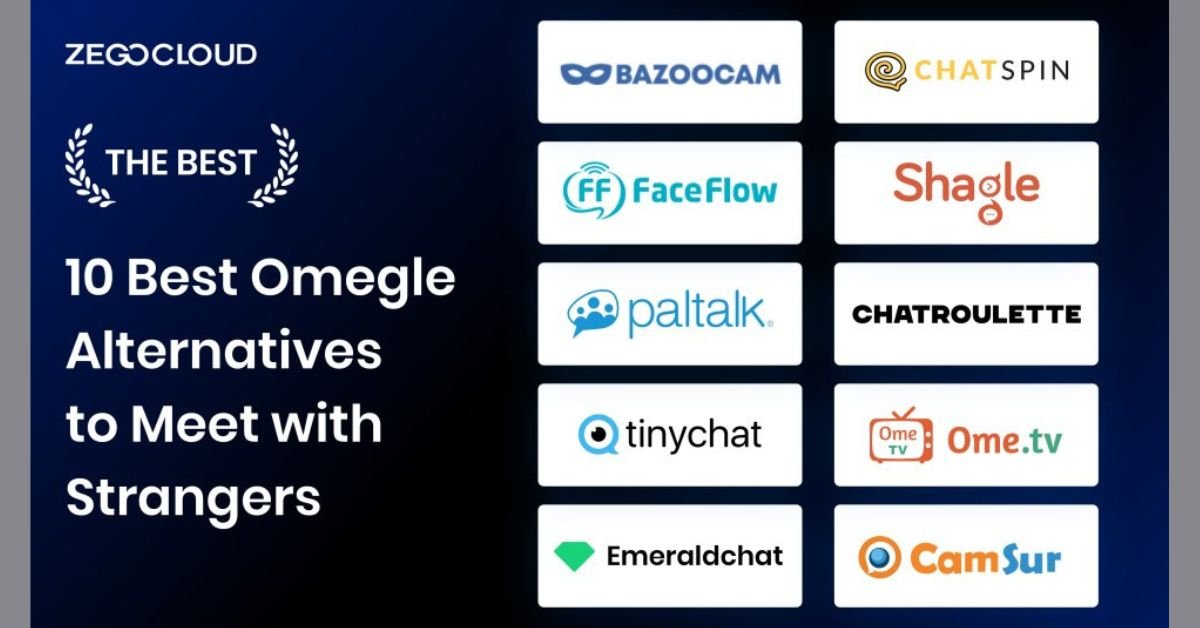Entertainment
Discover Alternatives: Top Websites Like Omegle for Random Video Chats

If you’re looking to connect with strangers online through random video chats, Omegle may not be your only option. While Omegle was one of the pioneering platforms for this type of experience, there are now several alternatives that offer similar features and experiences. In this article, we’ll explore some of the top websites like Omegle for random video chats.
TRENDING
Deeper Dive into myfavouriteplaces. org:// blog
Chatroulette
Chatroulette is one of the most well-known Omegle alternatives, having launched shortly after Omegle’s debut in 2009. Like Omegle, Chatroulette pairs users with random strangers for one-on-one video chats. The platform has a simple and straightforward interface, allowing users to quickly connect with new people around the world.One key difference between Chatroulette and Omegle is Chatroulette’s more mature user base. While Omegle tends to attract a younger crowd, Chatroulette has historically drawn in an older demographic, with users tending to be in their 20s and 30s. This can create a different vibe and conversation dynamic compared to Omegle.
Bazoocam
Bazoocam is another popular Omegle alternative that has been around since 2010. It offers a very similar random video chat experience, with the ability to quickly connect with strangers from all over the globe.What sets Bazoocam apart is its focus on moderation and safety. The platform has robust content filters to block inappropriate material, and users can report problematic behavior. This helps create a more controlled and family-friendly environment compared to some other random chat sites.
Tinychat
Tinychat is a versatile platform that offers both group video chats and one-on-one random video chat functionality, making it a viable Omegle alternative. The interface is clean and easy to navigate, allowing users to quickly find and connect with new people.One unique aspect of Tinychat is its support for creating custom chat rooms around specific topics or interests. This can be useful for users looking to connect with like-minded individuals, rather than just random strangers.
Camsurf
Camsurf is a mobile-focused random video chat app that has gained popularity as an Omegle alternative. It offers a similar experience of being paired with random users for one-on-one video conversations.What sets Camsurf apart is its emphasis on moderation and safety features. The app uses advanced AI to detect and filter out inappropriate content, and users can easily report any issues. This helps create a more controlled and positive environment for random video chats.
Chatous
Chatous is a unique Omegle alternative that combines random video chats with text-based messaging. Users can be paired with strangers for both video and text conversations, allowing for more in-depth interactions.One interesting aspect of Chatous is its focus on building communities around shared interests. Users can join themed chat rooms to connect with like-minded individuals, rather than just random strangers.
Conclusion
While Omegle may have been one of the first platforms to popularize random video chats, it’s clear that there are now several compelling alternatives available. Each of the websites we’ve explored – Chatroulette, Bazoocam, Tinychat, Camsurf, and Chatous – offer unique features and experiences that cater to different user preferences and needs.Whether you’re looking for a more mature user base, enhanced moderation and safety features, or the ability to connect around shared interests, there’s likely an Omegle alternative out there that will suit your needs. So why not explore some of these options and discover new ways to connect with strangers online through random video chats?
ALSO READ: ChillWithKira Ticket Show
Entertainment
Unveiling The 6.2mm Jap Arisaka Rifle: A Collector’s Dream

The 6.2mm Jap Arisaka Rifle, more commonly known as the Type A Arisaka, stands as a remarkable piece of military history and firearms engineering. Originally developed for the Imperial Japanese Army in the early 20th century, the Arisaka rifles have earned their place in the hearts of collectors, historians, and firearm enthusiasts alike. This article delves into the origins, design, features, and significance of the Arisaka rifle, while also providing insights for collectors interested in acquiring this iconic weapon.
TRENDING
Financial Domination Uncovered Best Findom Websites To Explore
Origins Of The Arisaka Rifle
Historical Context
The Arisaka rifle was developed during a period of military modernization in Japan, driven by the desire to enhance the capabilities of the Imperial Japanese Army. The rifle was named after its designer, Colonel Arisaka Nariakira, who sought to create a weapon that combined the best features of existing firearms with innovations in technology.
Development of the Type A
The Type A Arisaka, introduced in 1905, was among the first models of the Arisaka series. It was designed to replace the earlier Murata rifle and featured significant improvements in range, accuracy, and reliability. The 6.2mm cartridge was adopted for its effective performance on the battlefield.
Design And Features
Caliber and Ammunition
The 6.2mm Arisaka cartridge was designed to deliver superior ballistics while maintaining manageable recoil. This caliber was a departure from the larger, heavier cartridges commonly used in military rifles at the time, enabling soldiers to carry more ammunition without sacrificing performance.
Construction
Arisaka rifles were known for their robust construction and attention to detail. The Type A, like its successors, featured a bolt-action mechanism that provided reliability and ease of use. The rifle’s wooden stock and metal components were built to withstand the rigors of combat, ensuring that the Arisaka could perform in various environments.
Sights and Accessories
Equipped with a rear adjustable sight and a front blade sight, the Arisaka rifle offered precise aiming capabilities. Many models also came with accessories, such as bayonets and slings, enhancing their functionality in different combat scenarios.
Variants Of The Arisaka Rifle
The Arisaka rifle saw several variants throughout its production, each with unique characteristics. Understanding these differences is essential for collectors seeking to acquire a specific model.
Type A (1905)
The Type A was the first model and featured a 6.2mm caliber. It was designed primarily for infantry use and served during the early years of the Russo-Japanese War.
Type B (1910)
The Type B introduced improvements in the bolt mechanism and overall ergonomics. This model also saw a reduction in weight, making it more maneuverable for soldiers.
Type 38
One of the most famous variants, the Type 38, was introduced in 1905 and adopted for service in 1906. It featured a larger 6.5mm cartridge, reflecting advancements in ammunition technology.
Type 99
The Type 99, introduced in 1939, further modernized the Arisaka design. It was chambered for the more powerful 7.7mm cartridge and featured a range of improvements, including a monopod and anti-aircraft sights.
Collectibility And Market Value
Factors Influencing Value
The market for Arisaka rifles varies based on several factors, including rarity, condition, and historical significance. Some models are highly sought after, especially those with unique features or notable provenance.
Rarity: Certain variants of the Arisaka rifle were produced in limited numbers, making them more valuable to collectors.
Condition: The overall condition of the rifle plays a crucial role in determining its market value. Well-preserved examples command higher prices.
Provenance: Rifles with documented history, such as military service or previous ownership by notable figures, can significantly increase their worth.
Where to Buy
Collectors interested in acquiring Arisaka rifles can explore various avenues, including:
- Gun Shows: Local and national gun shows often feature vendors specializing in military firearms.
- Online Auctions: Websites dedicated to firearms auctions may have listings for Arisaka rifles from various eras.
- Specialty Gun Shops: Some gun shops focus on military collectibles and may have Arisaka rifles in stock.
- Private Sales: Networking with fellow collectors can lead to private sales or trades.
Maintenance And Care
Cleaning and Preservation
Proper maintenance is essential for preserving the condition and functionality of an Arisaka rifle. Here are some tips for collectors:
Regular Cleaning: Clean the barrel and action after each use to prevent rust and buildup of residue.
Lubrication: Apply a light coat of oil to metal parts to protect against corrosion.
Storage: Store the rifle in a climate-controlled environment to prevent damage from humidity and temperature fluctuations.
Restoration vs. Original Condition
Collectors often face the dilemma of whether to restore a rifle or keep it in its original condition. While restoration can enhance a rifle’s aesthetic appeal, it may also affect its historical value. It’s crucial to weigh these factors before making decisions about restoration.
Conclusion
The 6.2mm Jap Arisaka Rifle is not only a significant piece of military history but also a valuable collectible for enthusiasts. Its unique design, historical context, and impact on warfare make it a fascinating subject for study and collection. As with any collectible, understanding the nuances of the Arisaka rifle is vital for any potential collector looking to invest in this remarkable firearm.
ALSO READ: Mayane Eco: Leading The Way In Sustainable Innovations
FAQs
What is the 6.2mm Jap Arisaka Rifle?
The 6.2mm Jap Arisaka Rifle, often referred to as the Type A, is a bolt-action rifle developed for the Imperial Japanese Army in the early 20th century. It was designed for improved accuracy and reliability, utilizing the 6.2mm cartridge.
How many variants of the Arisaka rifle exist?
There are several variants of the Arisaka rifle, including the Type A (1905), Type B (1910), Type 38, and Type 99. Each model features distinct design improvements and caliber changes.
What factors affect the value of an Arisaka rifle?
The value of an Arisaka rifle is influenced by rarity, condition, and historical significance. Well-preserved and rare models are generally more valuable to collectors.
Where can I buy a 6.2mm Arisaka rifle?
Collectors can find Arisaka rifles at gun shows, online auctions, specialty gun shops, and through private sales among fellow collectors.
How should I maintain my Arisaka rifle?
To maintain your Arisaka rifle, regularly clean the barrel and action, apply a light coat of oil to metal parts, and store it in a climate-controlled environment to prevent damage.
Entertainment
Stylish Pup Hood: Ultimate Guide To Canine Fashion

A pup hood is a fashionable accessory designed to fit over your dog’s head and neck, similar to a human hoodie. It serves both functional and aesthetic purposes, providing warmth during colder months and adding a stylish flair to your pet’s wardrobe. Pup hoods come in various designs, colors, and materials, making it easy for pet owners to find the perfect match for their dog’s personality and style.
TRENDING
Discover A3 Kenya: Your Guide To Unique Travel Experiences
The Evolution Of Canine Fashion
Canine fashion has evolved dramatically over the past few decades. What started as basic protective gear for dogs has transformed into a booming industry with a wide array of clothing and accessories. From doggie sweaters to booties, owners are now looking for stylish ways to dress their pets. The pup hood is a relatively recent addition, combining comfort with style and catering to the increasing demand for fashionable pet apparel.
Why Choose A Pup Hood?
Choosing a pup hood for your dog offers several benefits, including:
Warmth and Comfort: Pup hoods are often made from cozy materials, providing extra warmth during cold weather.
Style: A stylish pup hood can enhance your dog’s appearance, allowing them to stand out in a crowd.
Versatility: Pup hoods are available in various designs, making them suitable for different occasions, whether it’s a walk in the park or a family gathering.
Protection: Hoods can protect your dog from wind, rain, and snow, ensuring they stay comfortable in various weather conditions.
Styles Of Pup Hoods
When it comes to pup hoods, there are many styles to choose from. Here are some popular options:
Classic Pup Hood
The classic pup hood is a simple yet stylish design that features a soft, fitted look. It is usually made from cotton or knit fabric and is perfect for everyday wear. Classic hoods come in various colors, allowing you to choose one that matches your dog’s personality.
Fleece Lined Hood
Fleece-lined pup hoods are ideal for colder climates. They feature a soft fleece lining that provides extra warmth and comfort, making them perfect for chilly walks. These hoods often come in vibrant colors and patterns, adding a fun element to your dog’s winter wardrobe.
Rain-Resistant Hood
For dogs that love to explore the outdoors, a rain-resistant pup hood is a practical choice. Made from waterproof materials, these hoods protect your dog from rain and moisture. Many rain-resistant hoods also feature reflective strips for added safety during nighttime walks.
Fashion-Forward Designs
Fashion-forward pup hoods come in various trendy designs, including patterns like leopard print, polka dots, and even seasonal themes like Halloween or Christmas. These hoods not only keep your dog warm but also make a stylish statement at dog parks or family events.
Materials Used In Pup Hoods
The material of a pup hood is essential for comfort and durability. Here are some common materials used in pup hoods:
Cotton: Soft and breathable, cotton is an excellent choice for warmer weather and everyday wear.
Fleece: Known for its warmth and softness, fleece is perfect for colder climates and provides excellent insulation.
Polyester: This synthetic fabric is often used in rain-resistant hoods due to its durability and water-resistant properties.
Wool: Wool hoods offer natural warmth and insulation, making them a great option for winter.
How To Choose The Right Pup Hood
Choosing the right pup hood involves considering several factors:
Size: Measure your dog’s head and neck to find the right size. Most brands offer size charts to help you choose the best fit.
Style: Consider your dog’s personality and your personal style when selecting a design. Whether you prefer classic or trendy styles, there’s a hood for every taste.
Material: Choose a material that suits your dog’s needs. For example, opt for fleece-lined hoods for cold weather or lightweight cotton for warmer days.
Functionality: If you live in a rainy area, a rain-resistant hood may be the best option. Consider the climate and activities when making your choice.
Caring For Your Pup Hood
To keep your pup hood in excellent condition, follow these care tips:
Read the Label: Always check the washing instructions on the label to avoid damage.
Regular Washing: Wash your dog’s hood regularly to keep it clean and free from dirt or odors.
Avoid Harsh Detergents: Use pet-friendly detergents to prevent skin irritations.
Air Dry: To maintain the shape and integrity of the fabric, air dry the hood instead of using a dryer.
Where To Buy Stylish Pup Hoods
Finding the perfect pup hood is easier than ever with the variety of shopping options available. Here are some places to consider:
Pet Supply Stores: Local pet shops often carry a range of stylish dog apparel, including pup hoods.
Online Retailers: Websites like Amazon, Chewy, and specialty pet fashion sites offer a wide selection of pup hoods in different styles and sizes.
Boutique Pet Stores: For unique designs, check out local boutique pet shops that specialize in fashionable dog apparel.
Craft Fairs and Markets: Sometimes, local artisans create unique, handmade pup hoods that can be found at craft fairs or pet expos.
Conclusion
Stylish pup hoods are more than just a trendy accessory; they provide warmth, protection, and a way for your dog to express their personality. With a variety of styles, materials, and options available, you can find the perfect pup hood to keep your furry friend comfortable and stylish. Remember to consider your dog’s size, the climate, and your style preferences when choosing the right hood. With proper care, your pup hood will be a staple in your dog’s wardrobe for many seasons to come.
ALSO READ: Edmin Rice Architecture: Innovative Designs For Modern Living
FAQs
What is a pup hood?
A pup hood is a fashionable accessory designed for dogs, resembling a human hoodie. It covers the dog’s head and neck, providing warmth and style.
How do I measure my dog for a pup hood?
To measure your dog, use a flexible measuring tape to measure the circumference of their neck and the distance from the neck to the top of the head. Compare these measurements to the size chart of the pup hood brand.
Can I wash my dog’s pup hood?
Yes, most pup hoods are machine washable. However, it’s important to check the care instructions on the label to ensure you wash it properly and maintain its quality.
Are pup hoods suitable for all dog breeds?
Pup hoods can be suitable for most dog breeds, but it’s essential to consider your dog’s size, head shape, and comfort level. Some breeds may not be comfortable wearing hoods.
Where can I find unique pup hoods?
You can find unique pup hoods at local boutique pet stores, online retailers specializing in pet fashion, or even craft fairs where local artisans sell handmade pet apparel.
Entertainment
Everything Everything Book: A Complete Overview And Analysis

 Entertainment5 months ago
Entertainment5 months agoSandra Orlow: Exploring the Life and Legacy of a Cultural Icon

 Business6 months ago
Business6 months agoTex9.Net Crypto: Fast, Secure International Money Transfers with Competitive Rates

 General1 month ago
General1 month agoDiana Nyad & Bart Springtime: A Swim to Success

 General1 month ago
General1 month agoBaby Alien Fan Bus: Watch Parts 2 & 3 on Twitter, Reddit!

 Business6 months ago
Business6 months agoSnapchat Planets: Exploring Your Streak Universe

 General4 months ago
General4 months agoDeeper Dive into myfavouriteplaces. org:// blog

 Business6 months ago
Business6 months agoFintechZoom Apple Stock: Real-Time Insights and Expert Analysis

 Business6 months ago
Business6 months agoWhat is O Farming: How to Make Money Online and Its Start-Up Benefits

















